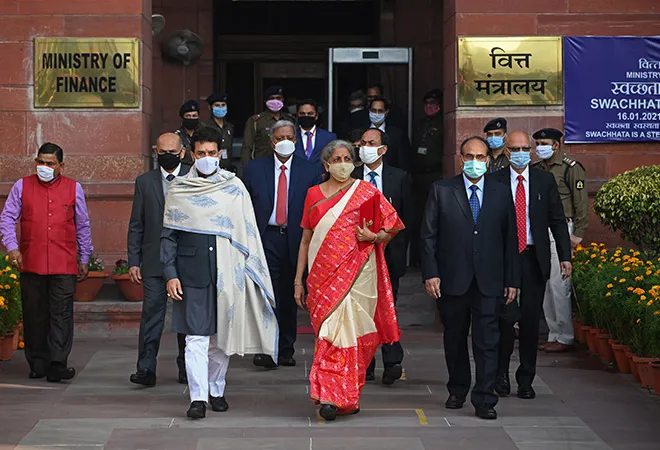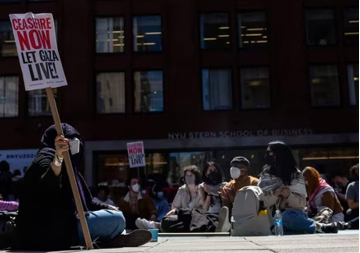
The economic policy force for 2020 was the brake. That of 2021 is the accelerator.
The lockdown-to-growth shift in policy stance, in the face of an unrelenting spend-more-spend-now criticism, is a courageous task, and tells the world that India has reached a mature phase of its policymaking. Effectively, this change shows that India hasn’t and doesn’t need to lean on what the Western nations are doing and follow blindly. India will carve its own path, at its own pace. That this path is now a global benchmark is something analysts across the world — and several in India too — need to recognise, learn from and follow.
There are five reasons why Finance Minister Nirmala Sitharaman’s third Budget needs to be lauded and one reason why Prime Minister Narendra Modi be commended.
First, a lower-than-expected fiscal deficit. The fiscal deficit for 2020-21 has been estimated at 9.5 percent, while that of 2021-22 stands at 6.8 percent. Given that this number has taken into account all the off-Budget items into consideration, this is even better. Under normal circumstances, these would have been called doomsday numbers. But in tune with global trends and fiscal loosening, with the idea carved out in G20 deliberations in 2020, a higher fiscal deficit is here to stay. Economy after economy will follow through. Of course, these numbers cannot sustain forever and must fall. Budget 2021 intends to reach a fiscal deficit of 4.5 percent by 2025-26. The COVID crisis is not yet over and the number was expected to be higher than 6.8 percent. This expectation illustrates that while the government is willing to spend, it is not doing to do so blindly. On the other hand, it is spending at the right time. And it is leaning on a nominal economic growth of 15 percent — 11 percent real growth plus 4 percent inflation.
Second, an indefatigable focus on infrastructure. Budget 2021 sees a 34.5 percent increase in capital expenditure to INR 5.54 lakh crore, with an additional INR 2 lakh crore for states and autonomous bodies. This bodes well. The money is being utilised to create assets that will catalyse future growth. These include roads, railways, urban infrastructure, and power. Railways, for instance, will see a capital expenditure of INR 1 lakh crore. Further, Budget 2021 locks the next few Union Budgets to similar spending. The INR 3 lakh crore outlay in power distribution, for instance, is spread over five years. Which means, Sitharaman is viewing infrastructure not as a one-time piecemeal investment of the hour but a flow over to the future. Something like a systematic investment plan. Once this spending begins, it will take one quarter for private companies to begin their investment plans around it. All of which converge at a single political economy statistic: Jobs.
Third, there are no new taxes. Again, with so much pressure on public finances, the easy way would have been to raise taxes. Corporate taxes are an easy target; they were spared. The rich is another easy target; they were spared too. A rejig of taxes for lower categories did not happen. There were no additional surcharges — much was discussed about a COVID surcharge. This is probably because of rising GST collections. A day before the Budget, the GST collections had touched their all-time high of almost INR 1.2 lakh crore. This is real money, not notional gains. It illustrates that, perhaps, economic activity and growth are a future that is already cooking. Destroying this growth with new taxes would have killed entrepreneurial enthusiasm and business stability. Sitharaman needs to be commended for this policy restraint.
Fourth, ease of compliance. On their own, high taxes hurt. But when you combine them with complex compliances, hurt turns to hate. FM Sitharaman has focussed on easing compliances. In fact, there are as many as 21 references to the word ‘compliance’ in Budget 2021. These range from raising thresholds for small companies to labour compliances to tax compliances to faceless processes to senior citizens. Citizens above the age of 75, for instance, will not have to file income tax returns if their income is from pension and interest. At the company level, Sitharaman has proposed a National Faceless Income Tax Appellate Tribunal Centre, where all communication between the Tribunal and the appellant will be in electronic mode.
Fifth, the creation of a bad bank. On the financial front, Budget 2021 has proposed the setting up of asset reconstruction and an asset management company to consolidate and take over stressed debt of public sector banks (PSBs) and sell them to alternate investment funds and other investors for value realisation. This will ease the pressure on the non-performing assets of PSBs. Whether it will also create a moral hazard remains an open question. In the financial sector, the creation of a new development financial institution is bad idea that belongs to the 1960s and one that has been given up after 1991. While it is in tune with the infrastructure push of the government, with an ambition of an INR 5 lakh crore lending portfolio, its creation is an idea that died long ago. At best this will be a sinecure for retired bureaucrats.
And sixth, disinvestment. Budget 2021 proposes to privatise two PSBs and one general insurance company. Apart from this, Sitharaman also proposes to bring out the IPO of LIC. This will deepen capital markets. In fact, LIC will enter the Sensex within a week of its listing. Finally, she is drawing up a list of other public sector enterprises that can be taken up for strategic sale. Small as these disinvestments may be, they are bold steps when contexted within the confines of India’s political economy — the middlemen and rich farmer agitation is not over and the government is opening another flank on the labour union side. This shows a conviction to bring in economic reforms, whatever the price. Prime Minister Narendra Modi needs to be commended for taking this political risk.
A hard lockdown in 2020 saved millions of lives that the world expected to be extinguished. India has been leading the discourse on the health and economic policy front. In fact, after criticising the Indian government for shutting down economic activity, the rest of the world is today following through, after several deaths. Designing economic policy between two equal and opposite forces — brakes due to lockdown and accelerator following that — at the right time, Budget 2021 makes space for itself as a document that shows resilience of the government and courage to deliver reforms.
The views expressed above belong to the author(s). ORF research and analyses now available on Telegram! Click here to access our curated content — blogs, longforms and interviews.




 PREV
PREV


